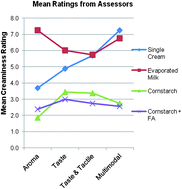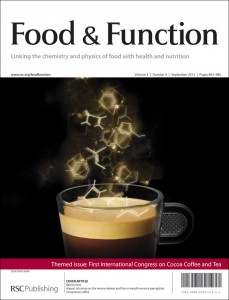Creaminess is a popular sensory feature of many fat-containing foods, particularly dairy foods such as ice creams, yoghurts and sauces and has an important influence on consumers’ preferences. A consumer has no difficulty distinguishing a creamy food from a non-creamy one; however, the exact meaning of the sensory term is unclear despite wide study. There is an increasing consumer demand for healthier fat-reduced food and although there are many different types of fat replacers which mimic some aspects of fat there is no replacer that can really mimic creaminess due to the lack of understanding of the sensory feature.
 Two main theories have emerged to explain creaminess, one that it is a chemical process based on molecule detection by taste buds, the other that it is a physical process based on sensing by mechanoreceptors and nerve endings in the mouth. Although the two theories are contradictory, both have experimental evidence to support them.
Two main theories have emerged to explain creaminess, one that it is a chemical process based on molecule detection by taste buds, the other that it is a physical process based on sensing by mechanoreceptors and nerve endings in the mouth. Although the two theories are contradictory, both have experimental evidence to support them.
The aim of this investigation by Jianshe Chen and Louise Eaton from the University of Leeds, UK, was to determine the main sensory stimuli and sensation mechanisms of food creaminess. The sensory creaminess of a set of four viscosity-matched fluid foods (single cream, evaporated milk, corn starch solution, and corn starch solution containing long chain free fatty acids) was tested by a panel of 16 assessors via controlled sensation mechanisms of smell only, taste only, taste and tactile and integrated multimodal. The results showed that assessors were able to detect creaminess among fat-containing and non-fat-containing samples using smell, taste, tactile and multimodal inputs. As the number of sensory cues is increased, the assessor’s capability in distinguishing food creaminess also increases. Based on these findings, one may conclude that:
- Sensation and perception of creaminess is a complicated sensory experience, involving olfactory, gustatory, tactile, as well as visual mechanisms. The appearance of a product and its flavour make important contributions in the perception of food creaminess
- Food creaminess is not a primary sensory property detected only via either chemical or physical mechanisms, but is an integrated sensory feature derived from a number of primary sensory factors (smell, taste, tactile, visual, etc.)
- long chain fatty acids play no significant role in the perception of food creaminess.
 Interested in knowing more? Read the full article for free until 28th September
Interested in knowing more? Read the full article for free until 28th September
Multimodal mechanisms of food creaminess sensation, Jianshe Chen and Louise Eaton, Food Funct., 2012, Advance Article
You may also be interested in this recently published article, free till the end of September, which features on the cover of the current issue of Food & Function, a themed issue on cocoa, coffee and tea.
Impact of crema on the aroma release and the in-mouth sensory perception of espresso coffee, D. Barron, N. Pineau, W. Matthey-Doret, S. Ali, J. Sudre, J. C. Germain, E. Kolodziejczyk, P. Pollien, D. Labbe, C. Jarisch, V. Dugas, C. Hartmann and B. Folmer, Food Funct., 2012, 3, 923-930
You can keep up to date with the latest developments from Food & Function by signing up for free table of contents alerts and monthly e-newsletters.










